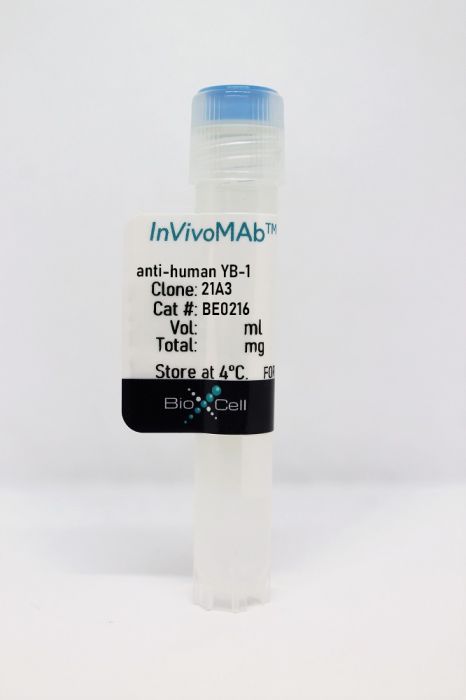InVivoMAb anti-human YB-1
Product Details
The 21A3 monoclonal antibody reacts with human Y-box binding protein 1 (YB-1) a highly conserved protein that has broad nucleic acid binding properties. YB-1 binds DNA and RNA and plays a role in multiple cellular processes including regulation of transcription and translation, pre-mRNA splicing, DNA reparation and mRNA packaging. YB-1 is also a component of messenger ribonucleoprotein complexes and may have a role in microRNA processing. Aberrant expression of YB-1 is associated with cancer proliferation in numerous tissues.Specifications
| Isotype | Mouse IgG1 |
|---|---|
| Recommended Isotype Control(s) | InVivoMAb mouse IgG1 isotype control, unknown specificity |
| Recommended Dilution Buffer | InVivoPure pH 7.0 Dilution Buffer |
| Conjugation | This product is unconjugated. Conjugation is available via our Antibody Conjugation Services. |
| Immunogen | Recombinant human YB-1 |
| Reported Applications |
Immunohistochemistry (paraffin) Western blot |
| Formulation |
PBS, pH 7.0 Contains no stabilizers or preservatives |
| Endotoxin |
<2EU/mg (<0.002EU/μg) Determined by LAL gel clotting assay |
| Purity |
>95% Determined by SDS-PAGE |
| Sterility | 0.2 µm filtration |
| Production | Purified from cell culture supernatant in an animal-free facility |
| Purification | Protein G |
| RRID | AB_2687701 |
| Molecular Weight | 150 kDa |
| Storage | The antibody solution should be stored at the stock concentration at 4°C. Do not freeze. |
Recommended Products
Immunohistochemistry (paraffin)
Hanzawa, K., et al. (2010). "Y-box binding protein-1 expression in diffuse large B-cell lymphoma: an impact on prognosis in the rituximab era" Leuk Lymphoma 51(11): 2054-2062. PubMed
The expression of YB-1 has been reported to predict poor clinical outcome in many human malignancies, including hematopoietic malignancies. In this study, we investigated the correlations between YB-1 expression and the clinicopathological features of patients with diffuse large B-cell lymphoma (DLBCL) in a single institution. The expression of YB-1 was analyzed in 168 cases by immunohistochemistry. Fifteen out of 168 cases (8.9%) showed cytoplasmic expression of YB-1. The expression of YB-1 was significantly associated with 5-year overall survival (OS) (p = 0.023). Rituximab plus CHOP therapy (n = 94) improved the 5-year survival rate in both YB-1-positive and -negative patients. In conclusion, the data presented in this report provide evidence that the cytoplasmic expression of YB-1 is a poor prognosis factor in DLBCL treated with CHOP therapy, whereas rituximab improves the survival of both YB-1-positive and -negative patients with DLBCL.
Immunohistochemistry (paraffin), Western Blot
Yasen, M., et al. (2005). "The up-regulation of Y-box binding proteins (DNA binding protein A and Y-box binding protein-1) as prognostic markers of hepatocellular carcinoma" Clin Cancer Res 11(20): 7354-7361. PubMed
PURPOSE: The development of hepatocellular carcinoma is associated with the chronic inflammation of the liver caused by various factors such as hepatitis B or C virus infection. Previously, we reported DNA binding protein A (dbpA) as a candidate molecule that can accelerate inflammation-induced hepatocarcinogenesis. DbpA belongs to the Y-box binding protein family, and Y-box binding protein-1 (YB-1), the prototype member of this family, is reported to be a prognostic marker of malignant diseases other than hepatocellular carcinoma. The purpose of this study is to examine the significance of the expression of dbpA or of the T-to-G transversion in the dbpA promoter region, which enhances the promoter activity in vitro, for the progression of hepatocellular carcinoma. EXPERIMENTAL DESIGN: We studied the expression of dbpA (as well as of YB-1) in 82 formalin-fixed hepatocellular carcinoma tissues by immunohistochemistry and determined the sequence of the dbpA promoter region in 42 frozen hepatocellular carcinoma tissues. We examined the relationship between these findings and the clinicopathologic factors of hepatocellular carcinoma patients. RESULTS: DbpA expression was associated with the advanced stages of hepatocellular carcinoma, and the cases with the nuclear dbpA expression had a poor prognosis. DbpA contributed more significantly to this association than YB-1. Furthermore, the T-to-G transversion in the dbpA promoter region was related to the nuclear localization of dbpA. CONCLUSION: DbpA was a more significant prognostic marker of hepatocellular carcinoma than YB-1. The T-to-G transversion in the dbpA promoter region was suggested to be a predisposing factor for the progression of hepatocellular carcinoma.



